

'Earliest shrine' uncovered at Buddha's birthplace. 25 November 2013Last updated at 19:58 ET By James Morgan Science reporter, BBC News.

Eight Bronze Age Boats Unearthed In Britain Go On Display (PHOTOS) Eight Bronze Age boats go on display this week in England after extremely meticulous preservation efforts.

The fleet of wooden boats -- which included one vessel that could still float -- was discovered between 2011 and 2012 at Must Farm in what was once a river bed outside the city of Peterborough, according to the Guardian. Over Libya's Coast - In Focus. Cradle of Stonehenge: interview with David Jacques.
Brazilian 'Atlantis': Submersible Finds Possible Evidence Of Continent Deep Beneath Atlantic Ocean. New Views of Ancient Culture Suggest Brutal Violence. They lived in well-planned cities, made exquisite jewelry, and enjoyed the ancient world's best plumbing. But the people of the sophisticated Indus civilization—which flourished four millennia ago in what is now Pakistan and western India—remain tantalizingly mysterious. Unable to decipher the Indus script, archaeologists have pored over beads, slivers of pottery, and other artifacts for insights into one of the world's first city-building cultures. Now scientists are turning to long-silent witnesses: human bones. Prehistoric metalwork discovered at Iron Age site, along with gaming pieces. Archaeologists from the University of Leicester in the UK have uncovered one of the biggest groups of Iron Age metal artefacts to be found in the region -- in addition to finding dice and gaming pieces.
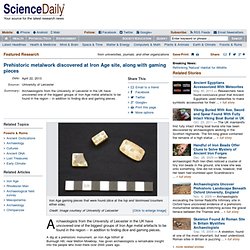
A dig at a prehistoric monument, an Iron Age hillfort at Burrough Hill, near Melton Mowbray, has given archaeologists a remarkable insight into the people who lived there over 2000 years ago. Both staff and students from the University's School of Archaeology and Ancient History and University of Leicester Archaeological Services are involved in the project, now in its fourth year. About 100 pieces, including iron spearheads, knives, brooches and a reaping hook, as well as decorative bronze fittings from buckets and trim from an Iron Age shield, have been found.
Roman industrial area uncovered in Egypt's Suez Canal - Greco-Roman - Heritage. Roman industrial area uncovered in Egypt's Suez Canal A fully furnished Graeco-Roman industrial area discovered on Thursday in Tell Abu-Seifi area, east of Egypt's Suez Canal Nevine El-Aref , Wednesday 24 Apr 2013 An Egyptian excavation mission from the Ministry of State for Antiquities (MSA) uncovered on Thursday a complete industrial area that can be dated to the Graeco-Roman era.
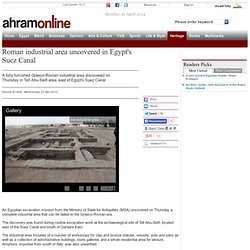
The discovery was found during routine excavation work at the archaeological site of Tell Abu-Seifi, located east of the Suez Canal and south of Qantara East. The industrial area includes of a number of workshops for clay and bronze statues, vessels, pots and pans as well as a collection of administrative buildings, store galleries and a whole residential area for labours. "It is a very important discovery that highlights Egypt’s economical and commercial relation with its neighbouring countries on the Mediterranean Sea," MSA Minister Mohamed Ibrahim told Ahram Online. New discovery solves ancient Egyptian chariot mystery. During routine archaeological research, a collection of 300 leather fragments of an Old Kingdom chariot were uncovered at the Egyptian Museum in Cairo.
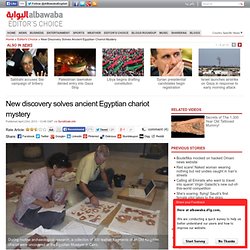
More > Create alert for CairoCairo During routine archaeological research as part of the Ancient Egypt Leatherwork Project (AELP) carried out by Salima Ikram, Professor of Egyptology at the American University in Cairo (AUC) and Andre Veldmeijer, head of the Egyptology section at the Netherlands Flemish Institute in Cairo, a collection of 300 leather fragments of an Old Kingdom chariot were uncovered at the Egyptian Museum in Cairo.
Ikram describes the discovery as very important and the collection as “extremely rare.” Making of Europe unlocked by DNA. DNA sequenced from nearly 40 ancient skeletons has shed light on the complex prehistoric events that shaped modern European populations.
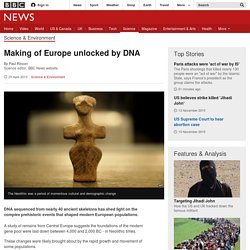
You don't have to go to the British Museum – Rome leads to all roads. At the British Museum in London is a massive exhibition from Pompeii and Herculaneum – cities near Naples in Italy that were overwhelmed by a volcanic eruption in AD79.
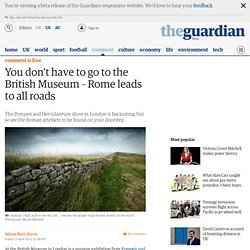
These extraordinary places and people, "frozen" as they died, display a unique glimpse of Roman life and death. One of my favourite pieces of graffiti can be seen, I am told, in a latrine in Herculaneum: APOLLONIUS MEDICUS TITI IMP. HIC CACARET BENE – in other words, "Apollonius, physician of the emperor Titus, had a good crap here". Just as fascinating is the news of the discovery of entire streets of Roman London, being excavated in the shadow of those glass-clad financial buildings, reminding us that Roman civilisation is much closer to home than we generally think, not just in the shadow of some faraway volcano, but under our own grey skies. There are writing tablets, love letters, clothes, buildings and a wooden door: it's the largest collection ever found in a single site in London.
Popular Archaeology. Archaeologists find 10,000 objects from Roman London. A fragment of a ceramic beaker unearthed at the London construction site.
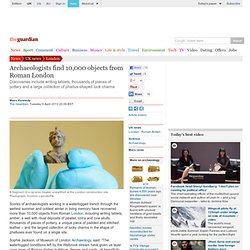
Photograph: Dominic Lipinski/PA Scores of archaeologists working in a waterlogged trench through the wettest summer and coldest winter in living memory have recovered more than 10,000 objects from Roman London, including writing tablets, amber, a well with ritual deposits of pewter, coins and cow skulls, thousands of pieces of pottery, a unique piece of padded and stitched leather – and the largest collection of lucky charms in the shape of phalluses ever found on a single site. Ancient Roman man hidden beneath famous painting at the Louvre. In the latest achievement in efforts to see what may lie underneath the surface of great works of art, scientists have described the first use of an imaging technology like that used in airport whole-body security scanners to detect the face of an ancient Roman man hidden below the surface of a wall painting in the Louvre Museum in Paris.

They described unveiling the image, which scientists and art historians say may be thousands of years old, during the 245th National Meeting & Exposition of the American Chemical Society. J. Bianca Jackson, Ph.D., who reported on the project, explained that it involved a fresco, which is a mural or painting done on a wall after application of fresh plaster. 'Entire streets' of Roman London uncovered in the City. 9 April 2013Last updated at 14:41 ET Archaeologists have found coins, pottery, shoes, lucky charms and an amber gladiator amulet An archaeological dig in the heart of the City "will transform our understanding" of Roman London, experts claim.

About 10,000 finds have been discovered, including writing tablets and good luck charms. Hatshepsut: First Female Pharaoh. Hatshepsut was the first female pharaoh of Egypt. She reigned between 1473 and 1458 B.C. Her name means “foremost of noblewomen.” Her rule was relatively peaceful and she was able to launch a building program that would see the construction of a great temple at Deir el-Bahari at Luxor. She also launched a successful sea voyage to the land of Punt, a place located somewhere on the northeast coast of Africa, where they traded with the inhabitants, bringing back “marvels.” Despite the apparent success of her reign, and a burial in the Valley of the Kings, her monuments would be defaced after her death, apparently by her co-ruler and step-son/nephew Thutmose III. Error loading player: No playable sources found.
New light shed on ancient Egyptian port and ship graveyard. New research into Thonis-Heracleion, a sunken port-city that served as the gateway to Egypt in the first millennium BC, will be discussed at an international conference at the University of Oxford (15-17 March). This obligatory port of entry, known as 'Thonis' by the Egyptians and 'Heracleion' by the Greeks, was where seagoing ships probably unloaded their cargoes to have them assessed by temple officials and taxes extracted before transferring them to Egyptian ships that went upriver.
Pluto's Gate Discovered: The Plutonium 'Gate To Hell' Found In Ancient City Of Hierapolis. JRR Tolkien ring goes on display at The Vyne exhibition. 2 April 2013Last updated at 19:06 ET The gold ring is inscribed in Latin and is connected to a curse An ancient gold ring thought to have inspired JRR Tolkien to write The Hobbit is on display at a Tudor house. The ring, which is inscribed in Latin and has been linked to a Roman curse tablet, is being exhibited for the first time at The Vyne, in Hampshire. Archaeologist Sir Mortimer Wheeler is believed to have discussed the ring with Tolkien after realising its connection to the curse. Life and Death: Pompeii and Herculaneum exhibition at the British Museum - video preview. Αρχαιολογία Online. Pre-Viking Tunic Found In Thawing Glacier Shows How Climate Change Aids Archaeology (PHOTO) Mummy Myths Debunked By New Study Of Ancient Egyptian Embalming Practices. By: Tia Ghose, LiveScience Staff Writer Published: 03/22/2013 12:51 PM EDT on LiveScience Contrary to reports by famous Greek historian Herodotus, the ancient Egyptians probably didn't remove mummy guts using cedar oil enemas, new research on the reality of mummification suggests.
The ancient embalmers also didn't always leave the mummy's heart in place, the researchers added. The findings, published in the February issue of HOMO – Journal of Comparative Human Biology, come from analyzing 150 mummies from the ancient world. Mummy history In the fifth century B.C., Herodotus, the "father of history," got an inside peek at the Egyptian mummification process. Herodotus described multiple levels of embalming: The elites, he said, got a slit through the belly, through which organs were removed.
In addition, Herodotus claimed the brain was removed during embalming and other accounts suggested the heart was always left in place. Mummy tales. In Small Things Forgotten. Disunion follows the Civil War as it unfolded. Stonehenge builders travelled from far, say researchers. 9 March 2013Last updated at 00:44 ET. Treasure-Filled Warrior's Grave Found in Russia. Recreating the Vestal Virgin Hairstyle. Popular Archaeology. Popular Archaeology. The immense ancient site could reveal more secrets about an otherwise well-known civilization that has eluded scientists and scholars for years. Sassanid Era Gold Coins Found In Iraq. Pozzino shipwreck: Ancient medicine ingredients probed. 7 January 2013Last updated at 16:36 ET By Rebecca Morelle Science reporter, BBC World Service The tablets were found in a small tin box, which kept them safe from corrosive sea water Medicine that is more than 2,000 years old has been analysed by scientists.
Archaeologists unearth more than 300 prehistoric clay figurines in Greece. Koutroulou Magoula figurine. Richard III's Face Reconstructed From English King's Skull. Now that Richard III's remains have been identified "beyond a reasonable doubt," scientists are trying to figure out what the English king looked like. DNA tests and other techniques confirmed that a battle-scarred skeleton found buried in ruins beneath a parking lot in Leicester, England was that of the monarch, researchers announced on Feb. 4.
King Richard III's Face 'Unveiled To The World' (PICTURES) Last-stand Neanderthals queried. 5 February 2013Last updated at 06:41 ET By Jonathan Amos Science correspondent, BBC News DNA studies confirm there was some mixing between Neanderthals and modern humans We may need to look again at the idea that a late Neanderthal population existed in southern Spain as recently as 35,000 years ago, a study suggests. Richard III: Facial reconstruction shows king's features. Digital dig: The scanning technology revolutionising archaeology. Richard III dig: Grim clues to the death of a king. Richard III: The twisted bones that reveal a king. Richard III dig: DNA confirms bones are king's. The Bluffer’s Guide To Middle East Mayhem [VIDEO] Ancient Egyptian Mummy's Elaborate Hairstyle Recreated In 3D.
January 10th: Julius Caesar Makes His Historic, Illegal Crossing of the Rubicon at the Head of a Legion of Soldiers, Starting a Civil War Within Rome. Ancient tombs unearthed in Egyptian city of Luxor. Archeologists examine one of the oldest hoards found in Europe. Europe's oldest prehistoric town unearthed in Bulgaria.
Mummy unwrapping brought Egyptology to the public. Chemical analysis reveals first cheese-making in Northern Europe 7,000 years ago. Oldest Pharaoh Carvings, Rediscovered In Egypt, May Be From Reign Of Narmer. Disability history month: Was Tamerlane disabled? A Point of View: Pompeii's not-so-ancient Roman remains. Skeletons in cave reveal Mediterranean secrets. Chinese terra cotta warriors had real, and very carefully made, weapons. Reconstructed 1918 influenza virus has yielded key insights, scientists say. Richard III dig: 'Strong evidence' bones are lost king.
We spend $750 billion on unnecessary health care. Two charts explain why. ‘Everything people think they know about the stimulus is wrong’ What We Already Knew About The Tea Party And ‘The Newsroom’ Finally Said Out Loud. A Simple Image, A Quote From John Lennon, And A Small Step Toward Healing. The One Where Jon Stewart Does A Better Job Reporting The Truth About 9/11 Than The News Does. Paul Krugman: Republican Party's Base 'Is By And Large Elderly White People Arguing With Empty Chairs'
How Not To Respond To The GOP's Far Right Vision Of The Constitution. Evaluation of microscopy techniques may help scientists to better understand ancient plants. Surprises in evolution of frog life cycles. Psychopathic boldness tied to U.S. presidential success. Archaeological dig inches 'tantalizingly closer' to possible burial place of King Richard III. Excavations in Jaffa confirm presence of Egyptian settlement on the ancient city site.